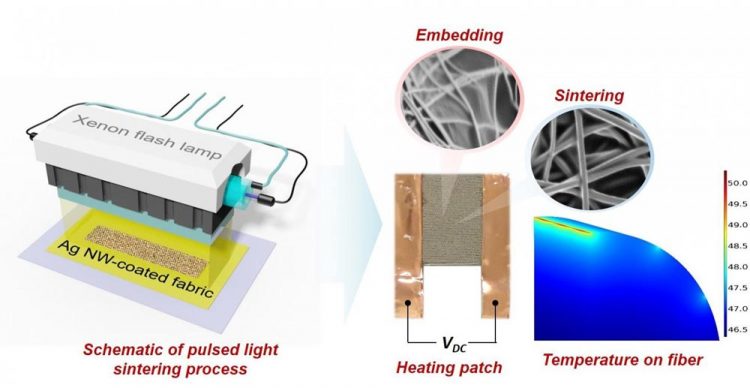An energy-efficient way to stay warm: Sew high-tech heating patches to your clothes

This image shows how to make a personal heating patch from polyester fabric fused with tiny silver wires, using pulses of intense light from a xenon lamp. Credit: Hyun-Jun Hwang and Rajiv Malhotra/Rutgers University-New Brunswick
What if, instead of turning up the thermostat, you could warm up with high-tech, flexible patches sewn into your clothes – while significantly reducing your electric bill and carbon footprint?
Engineers at Rutgers and Oregon State University have found a cost-effective way to make thin, durable heating patches by using intense pulses of light to fuse tiny silver wires with polyester. Their heating performance is nearly 70 percent higher than similar patches created by other researchers, according to a Rutgers-led study in Scientific Reports.
They are inexpensive, can be powered by coin batteries and are able to generate heat where the human body needs it since they can be sewed on as patches.
“This is important in the built environment, where we waste lots of energy by heating buildings – instead of selectively heating the human body,” said senior author Rajiv Malhotra, an assistant professor in the Department of Mechanical and Aerospace Engineering at Rutgers University-New Brunswick. The department is in the School of Engineering.
It is estimated that 47 percent of global energy is used for indoor heating, and 42 percent of that energy is wasted to heat empty space and objects instead of people, the study notes. Solving the global energy crisis – a major contributor to global warming – would require a sharp reduction in energy for indoor heating.
Personal thermal management, which focuses on heating the human body as needed, is an emerging potential solution. Such patches may also someday help warm anyone who works or plays outdoors.
The Rutgers and Oregon State engineers created highly efficient, flexible, durable and inexpensive heating patches by using “intense pulsed-light sintering” to fuse silver nanowires – thousands of times thinner than a human hair – to polyester fibers, using pulses of high-energy light. The process takes 300 millionths of a second, according to the study funded by the National Science Foundation and Walmart U.S. Manufacturing Innovation Fund.
When compared with the current state of the art in thermal patches, the Rutgers and Oregon State creation generates more heat per patch area and is more durable after bending, washing and exposure to humidity and high temperature.
Next steps include seeing if this method can be used to create other smart fabrics, including patch-based sensors and circuits. The engineers also want to determine how many patches would be needed and where they should be placed on people to keep them comfortable while reducing indoor energy consumption.
Media Contact
All latest news from the category: Power and Electrical Engineering
This topic covers issues related to energy generation, conversion, transportation and consumption and how the industry is addressing the challenge of energy efficiency in general.
innovations-report provides in-depth and informative reports and articles on subjects ranging from wind energy, fuel cell technology, solar energy, geothermal energy, petroleum, gas, nuclear engineering, alternative energy and energy efficiency to fusion, hydrogen and superconductor technologies.
Newest articles

NASA: Mystery of life’s handedness deepens
The mystery of why life uses molecules with specific orientations has deepened with a NASA-funded discovery that RNA — a key molecule thought to have potentially held the instructions for…

What are the effects of historic lithium mining on water quality?
Study reveals low levels of common contaminants but high levels of other elements in waters associated with an abandoned lithium mine. Lithium ore and mining waste from a historic lithium…

Quantum-inspired design boosts efficiency of heat-to-electricity conversion
Rice engineers take unconventional route to improving thermophotovoltaic systems. Researchers at Rice University have found a new way to improve a key element of thermophotovoltaic (TPV) systems, which convert heat…



